Business Analysis Report: VR Information System for Museum Experience
VerifiedAdded on 2023/04/05
|12
|2733
|150
Report
AI Summary
This report provides a business analysis of a virtual reality (VR) information system implemented in a museum, focusing on enhancing visitor experience. The VR application, developed by SAMCAR Solutions, aims to improve the way visitors interact with colonial artifacts by offering immersive virtual tours. The report examines the organization's goals and policies behind the VR system's development, detailing SAMCAR's focus on immersive technologies and their application across various industries. It specifies user stories to capture system requirements, identifies key stakeholders (including visitors, museum staff, SAMCAR Solutions, and community decision-makers), and links stakeholders to specific requirements. The analysis uses observation as a requirement elicitation method. The report emphasizes the importance of stakeholder engagement and proper integration to ensure the successful implementation of the VR app and better customer satisfaction.
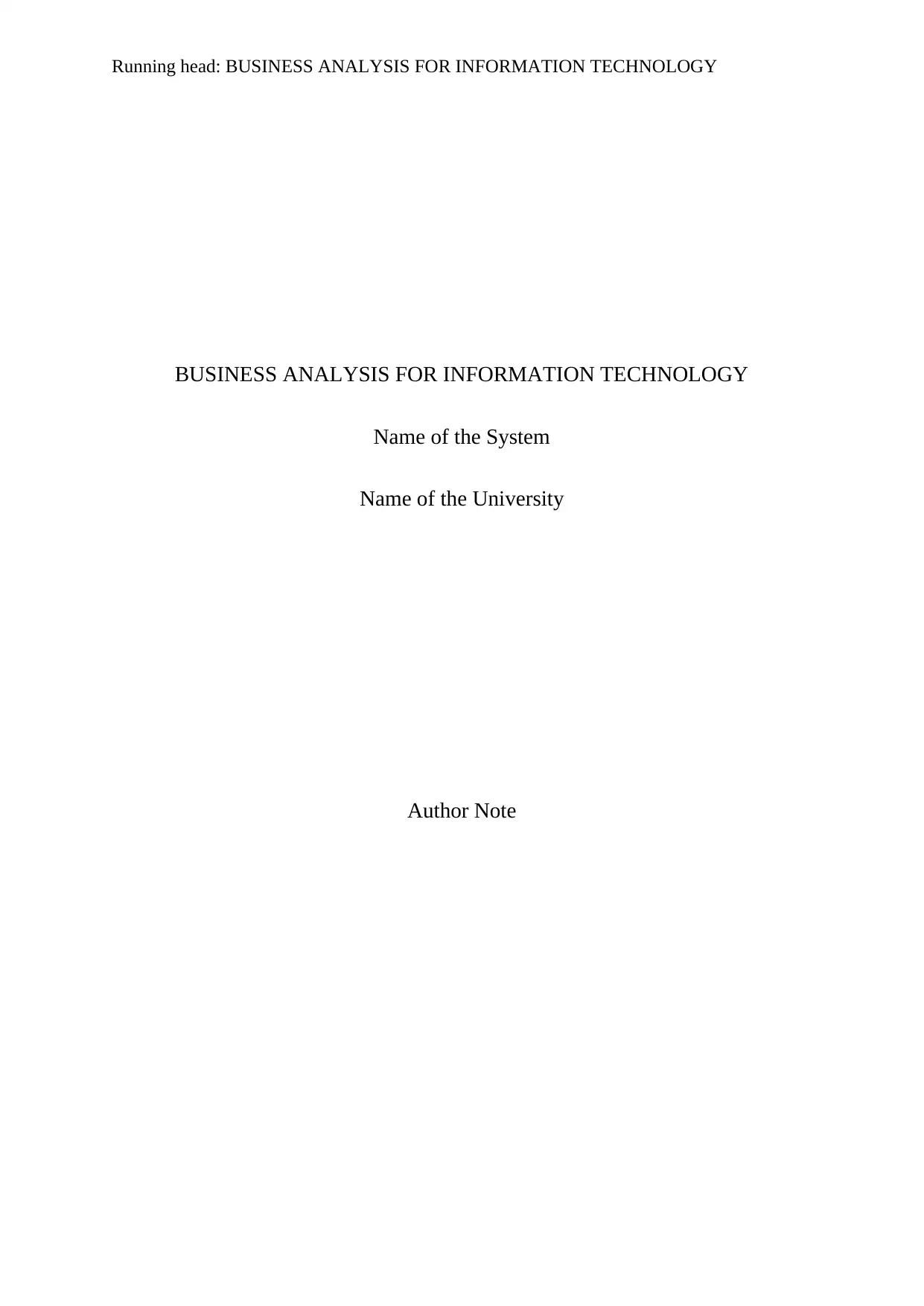
Running head: BUSINESS ANALYSIS FOR INFORMATION TECHNOLOGY
BUSINESS ANALYSIS FOR INFORMATION TECHNOLOGY
Name of the System
Name of the University
Author Note
BUSINESS ANALYSIS FOR INFORMATION TECHNOLOGY
Name of the System
Name of the University
Author Note
Paraphrase This Document
Need a fresh take? Get an instant paraphrase of this document with our AI Paraphraser
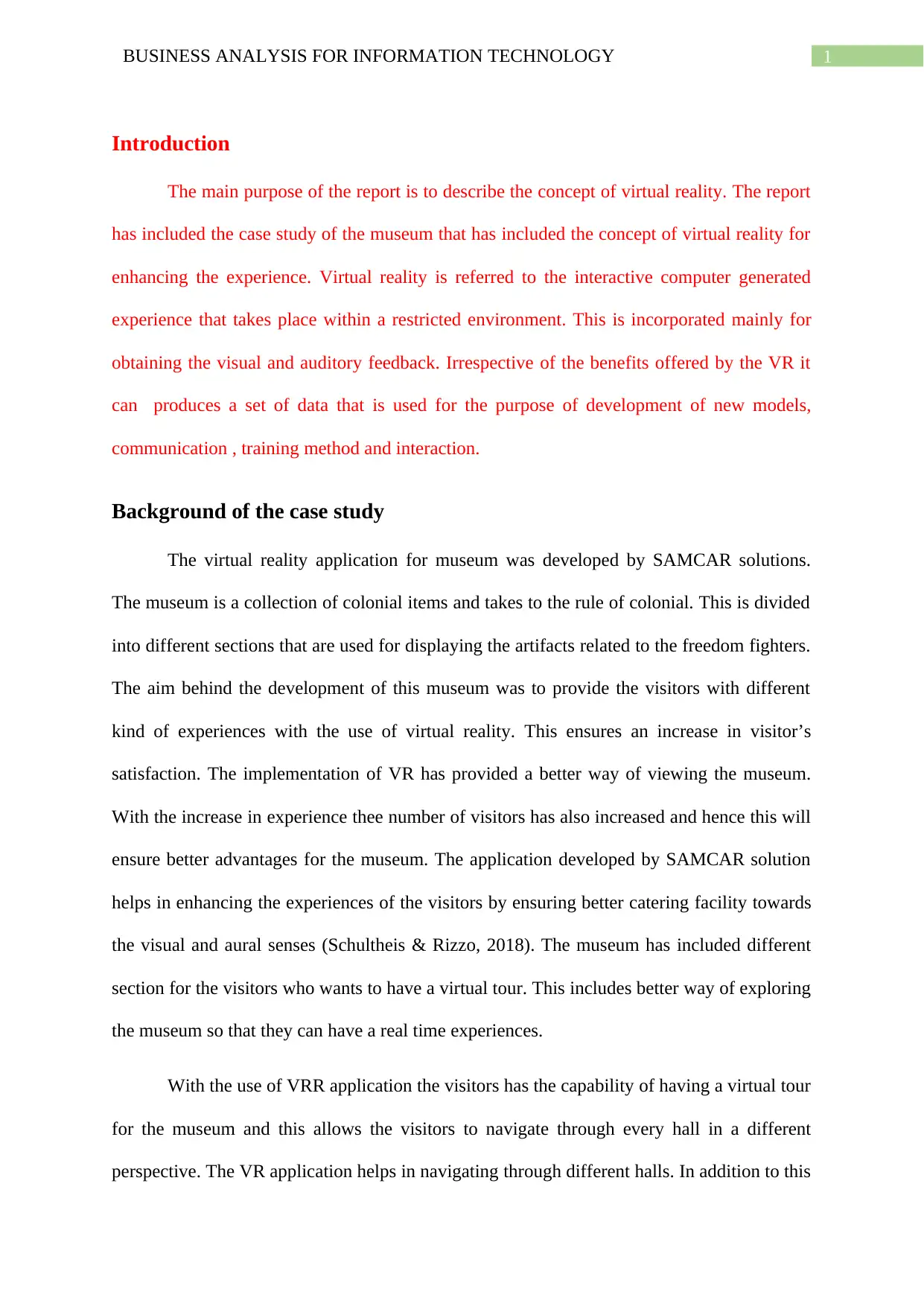
1BUSINESS ANALYSIS FOR INFORMATION TECHNOLOGY
Introduction
The main purpose of the report is to describe the concept of virtual reality. The report
has included the case study of the museum that has included the concept of virtual reality for
enhancing the experience. Virtual reality is referred to the interactive computer generated
experience that takes place within a restricted environment. This is incorporated mainly for
obtaining the visual and auditory feedback. Irrespective of the benefits offered by the VR it
can produces a set of data that is used for the purpose of development of new models,
communication , training method and interaction.
Background of the case study
The virtual reality application for museum was developed by SAMCAR solutions.
The museum is a collection of colonial items and takes to the rule of colonial. This is divided
into different sections that are used for displaying the artifacts related to the freedom fighters.
The aim behind the development of this museum was to provide the visitors with different
kind of experiences with the use of virtual reality. This ensures an increase in visitor’s
satisfaction. The implementation of VR has provided a better way of viewing the museum.
With the increase in experience thee number of visitors has also increased and hence this will
ensure better advantages for the museum. The application developed by SAMCAR solution
helps in enhancing the experiences of the visitors by ensuring better catering facility towards
the visual and aural senses (Schultheis & Rizzo, 2018). The museum has included different
section for the visitors who wants to have a virtual tour. This includes better way of exploring
the museum so that they can have a real time experiences.
With the use of VRR application the visitors has the capability of having a virtual tour
for the museum and this allows the visitors to navigate through every hall in a different
perspective. The VR application helps in navigating through different halls. In addition to this
Introduction
The main purpose of the report is to describe the concept of virtual reality. The report
has included the case study of the museum that has included the concept of virtual reality for
enhancing the experience. Virtual reality is referred to the interactive computer generated
experience that takes place within a restricted environment. This is incorporated mainly for
obtaining the visual and auditory feedback. Irrespective of the benefits offered by the VR it
can produces a set of data that is used for the purpose of development of new models,
communication , training method and interaction.
Background of the case study
The virtual reality application for museum was developed by SAMCAR solutions.
The museum is a collection of colonial items and takes to the rule of colonial. This is divided
into different sections that are used for displaying the artifacts related to the freedom fighters.
The aim behind the development of this museum was to provide the visitors with different
kind of experiences with the use of virtual reality. This ensures an increase in visitor’s
satisfaction. The implementation of VR has provided a better way of viewing the museum.
With the increase in experience thee number of visitors has also increased and hence this will
ensure better advantages for the museum. The application developed by SAMCAR solution
helps in enhancing the experiences of the visitors by ensuring better catering facility towards
the visual and aural senses (Schultheis & Rizzo, 2018). The museum has included different
section for the visitors who wants to have a virtual tour. This includes better way of exploring
the museum so that they can have a real time experiences.
With the use of VRR application the visitors has the capability of having a virtual tour
for the museum and this allows the visitors to navigate through every hall in a different
perspective. The VR application helps in navigating through different halls. In addition to this
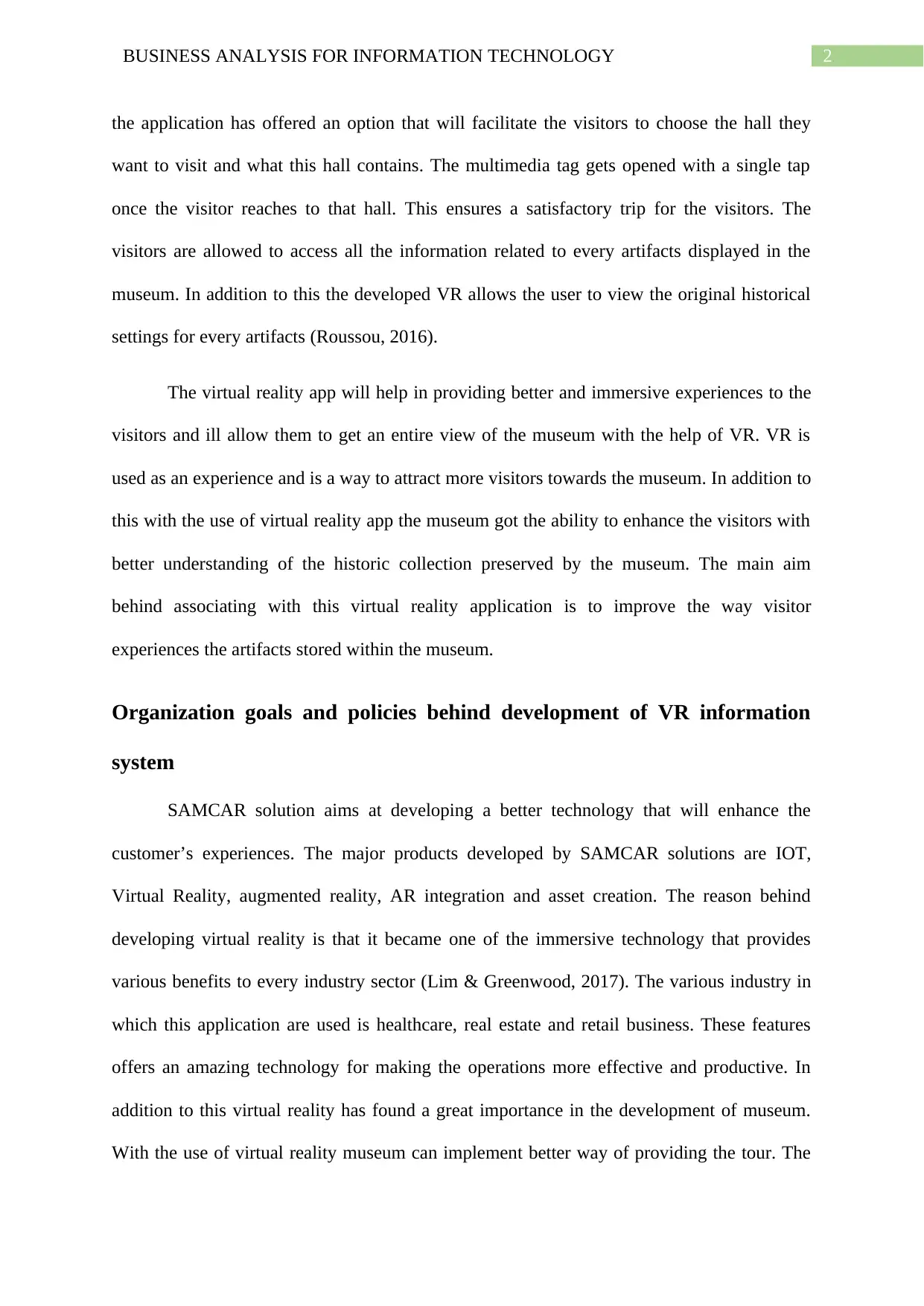
2BUSINESS ANALYSIS FOR INFORMATION TECHNOLOGY
the application has offered an option that will facilitate the visitors to choose the hall they
want to visit and what this hall contains. The multimedia tag gets opened with a single tap
once the visitor reaches to that hall. This ensures a satisfactory trip for the visitors. The
visitors are allowed to access all the information related to every artifacts displayed in the
museum. In addition to this the developed VR allows the user to view the original historical
settings for every artifacts (Roussou, 2016).
The virtual reality app will help in providing better and immersive experiences to the
visitors and ill allow them to get an entire view of the museum with the help of VR. VR is
used as an experience and is a way to attract more visitors towards the museum. In addition to
this with the use of virtual reality app the museum got the ability to enhance the visitors with
better understanding of the historic collection preserved by the museum. The main aim
behind associating with this virtual reality application is to improve the way visitor
experiences the artifacts stored within the museum.
Organization goals and policies behind development of VR information
system
SAMCAR solution aims at developing a better technology that will enhance the
customer’s experiences. The major products developed by SAMCAR solutions are IOT,
Virtual Reality, augmented reality, AR integration and asset creation. The reason behind
developing virtual reality is that it became one of the immersive technology that provides
various benefits to every industry sector (Lim & Greenwood, 2017). The various industry in
which this application are used is healthcare, real estate and retail business. These features
offers an amazing technology for making the operations more effective and productive. In
addition to this virtual reality has found a great importance in the development of museum.
With the use of virtual reality museum can implement better way of providing the tour. The
the application has offered an option that will facilitate the visitors to choose the hall they
want to visit and what this hall contains. The multimedia tag gets opened with a single tap
once the visitor reaches to that hall. This ensures a satisfactory trip for the visitors. The
visitors are allowed to access all the information related to every artifacts displayed in the
museum. In addition to this the developed VR allows the user to view the original historical
settings for every artifacts (Roussou, 2016).
The virtual reality app will help in providing better and immersive experiences to the
visitors and ill allow them to get an entire view of the museum with the help of VR. VR is
used as an experience and is a way to attract more visitors towards the museum. In addition to
this with the use of virtual reality app the museum got the ability to enhance the visitors with
better understanding of the historic collection preserved by the museum. The main aim
behind associating with this virtual reality application is to improve the way visitor
experiences the artifacts stored within the museum.
Organization goals and policies behind development of VR information
system
SAMCAR solution aims at developing a better technology that will enhance the
customer’s experiences. The major products developed by SAMCAR solutions are IOT,
Virtual Reality, augmented reality, AR integration and asset creation. The reason behind
developing virtual reality is that it became one of the immersive technology that provides
various benefits to every industry sector (Lim & Greenwood, 2017). The various industry in
which this application are used is healthcare, real estate and retail business. These features
offers an amazing technology for making the operations more effective and productive. In
addition to this virtual reality has found a great importance in the development of museum.
With the use of virtual reality museum can implement better way of providing the tour. The
⊘ This is a preview!⊘
Do you want full access?
Subscribe today to unlock all pages.

Trusted by 1+ million students worldwide
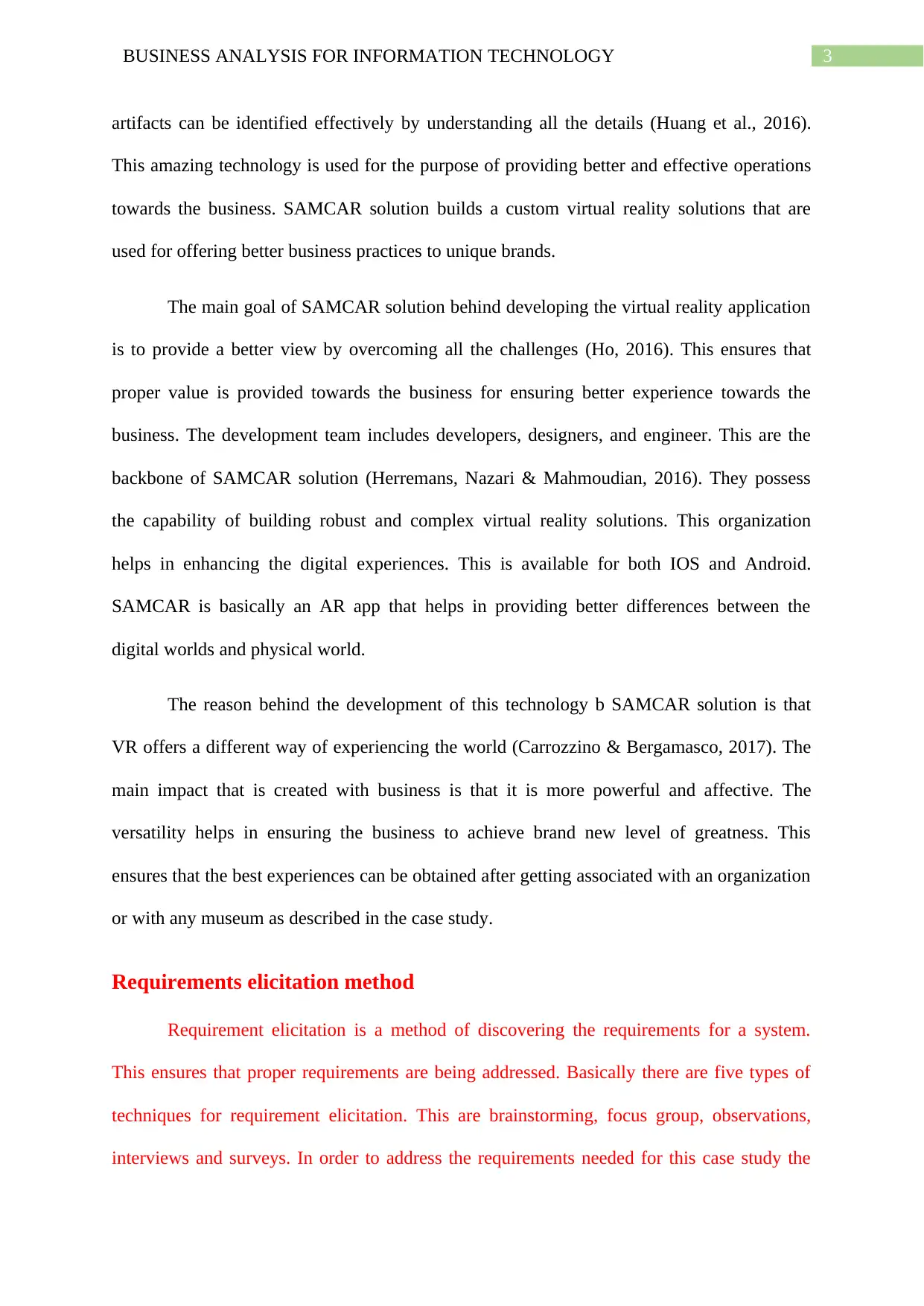
3BUSINESS ANALYSIS FOR INFORMATION TECHNOLOGY
artifacts can be identified effectively by understanding all the details (Huang et al., 2016).
This amazing technology is used for the purpose of providing better and effective operations
towards the business. SAMCAR solution builds a custom virtual reality solutions that are
used for offering better business practices to unique brands.
The main goal of SAMCAR solution behind developing the virtual reality application
is to provide a better view by overcoming all the challenges (Ho, 2016). This ensures that
proper value is provided towards the business for ensuring better experience towards the
business. The development team includes developers, designers, and engineer. This are the
backbone of SAMCAR solution (Herremans, Nazari & Mahmoudian, 2016). They possess
the capability of building robust and complex virtual reality solutions. This organization
helps in enhancing the digital experiences. This is available for both IOS and Android.
SAMCAR is basically an AR app that helps in providing better differences between the
digital worlds and physical world.
The reason behind the development of this technology b SAMCAR solution is that
VR offers a different way of experiencing the world (Carrozzino & Bergamasco, 2017). The
main impact that is created with business is that it is more powerful and affective. The
versatility helps in ensuring the business to achieve brand new level of greatness. This
ensures that the best experiences can be obtained after getting associated with an organization
or with any museum as described in the case study.
Requirements elicitation method
Requirement elicitation is a method of discovering the requirements for a system.
This ensures that proper requirements are being addressed. Basically there are five types of
techniques for requirement elicitation. This are brainstorming, focus group, observations,
interviews and surveys. In order to address the requirements needed for this case study the
artifacts can be identified effectively by understanding all the details (Huang et al., 2016).
This amazing technology is used for the purpose of providing better and effective operations
towards the business. SAMCAR solution builds a custom virtual reality solutions that are
used for offering better business practices to unique brands.
The main goal of SAMCAR solution behind developing the virtual reality application
is to provide a better view by overcoming all the challenges (Ho, 2016). This ensures that
proper value is provided towards the business for ensuring better experience towards the
business. The development team includes developers, designers, and engineer. This are the
backbone of SAMCAR solution (Herremans, Nazari & Mahmoudian, 2016). They possess
the capability of building robust and complex virtual reality solutions. This organization
helps in enhancing the digital experiences. This is available for both IOS and Android.
SAMCAR is basically an AR app that helps in providing better differences between the
digital worlds and physical world.
The reason behind the development of this technology b SAMCAR solution is that
VR offers a different way of experiencing the world (Carrozzino & Bergamasco, 2017). The
main impact that is created with business is that it is more powerful and affective. The
versatility helps in ensuring the business to achieve brand new level of greatness. This
ensures that the best experiences can be obtained after getting associated with an organization
or with any museum as described in the case study.
Requirements elicitation method
Requirement elicitation is a method of discovering the requirements for a system.
This ensures that proper requirements are being addressed. Basically there are five types of
techniques for requirement elicitation. This are brainstorming, focus group, observations,
interviews and surveys. In order to address the requirements needed for this case study the
Paraphrase This Document
Need a fresh take? Get an instant paraphrase of this document with our AI Paraphraser
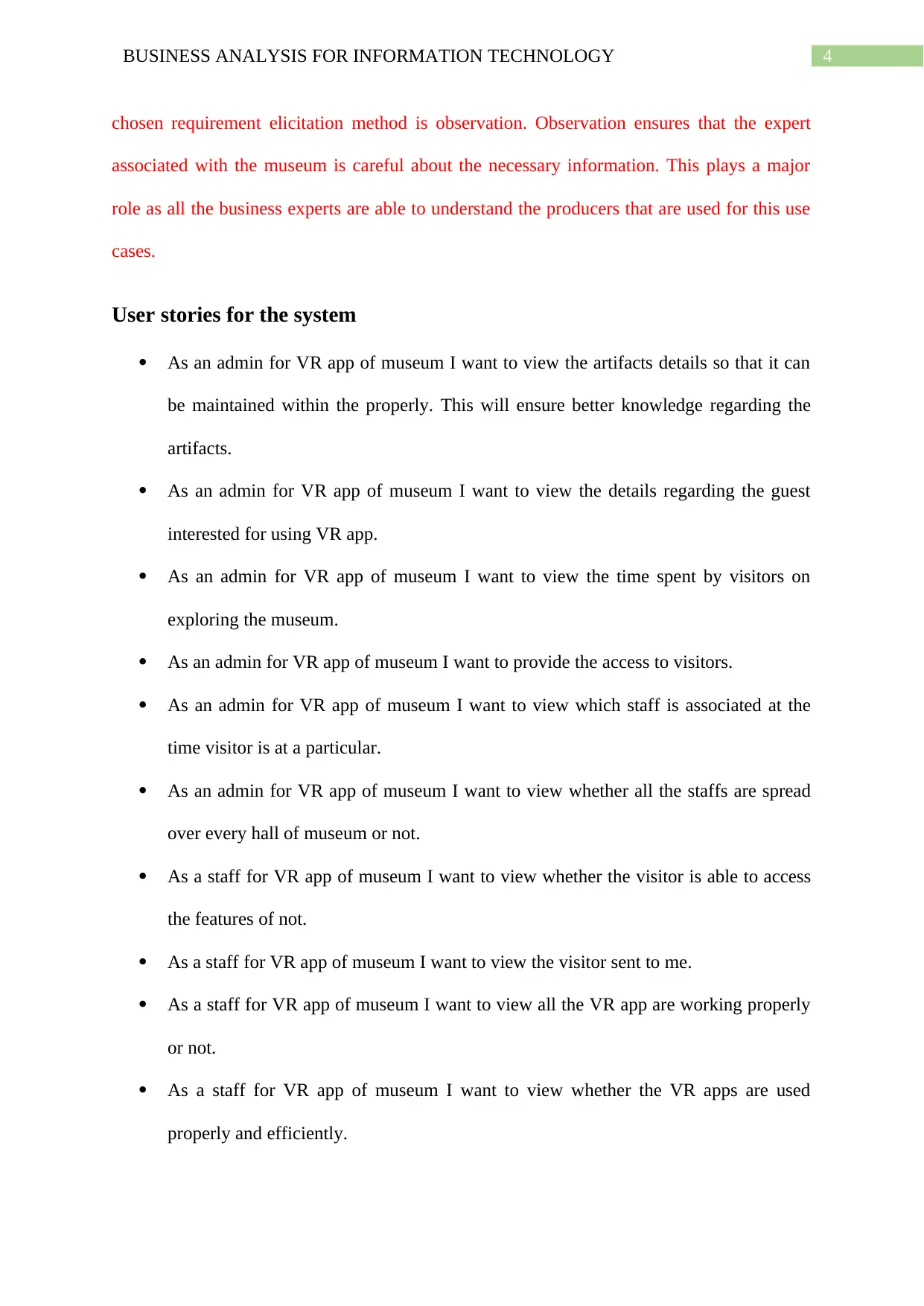
4BUSINESS ANALYSIS FOR INFORMATION TECHNOLOGY
chosen requirement elicitation method is observation. Observation ensures that the expert
associated with the museum is careful about the necessary information. This plays a major
role as all the business experts are able to understand the producers that are used for this use
cases.
User stories for the system
As an admin for VR app of museum I want to view the artifacts details so that it can
be maintained within the properly. This will ensure better knowledge regarding the
artifacts.
As an admin for VR app of museum I want to view the details regarding the guest
interested for using VR app.
As an admin for VR app of museum I want to view the time spent by visitors on
exploring the museum.
As an admin for VR app of museum I want to provide the access to visitors.
As an admin for VR app of museum I want to view which staff is associated at the
time visitor is at a particular.
As an admin for VR app of museum I want to view whether all the staffs are spread
over every hall of museum or not.
As a staff for VR app of museum I want to view whether the visitor is able to access
the features of not.
As a staff for VR app of museum I want to view the visitor sent to me.
As a staff for VR app of museum I want to view all the VR app are working properly
or not.
As a staff for VR app of museum I want to view whether the VR apps are used
properly and efficiently.
chosen requirement elicitation method is observation. Observation ensures that the expert
associated with the museum is careful about the necessary information. This plays a major
role as all the business experts are able to understand the producers that are used for this use
cases.
User stories for the system
As an admin for VR app of museum I want to view the artifacts details so that it can
be maintained within the properly. This will ensure better knowledge regarding the
artifacts.
As an admin for VR app of museum I want to view the details regarding the guest
interested for using VR app.
As an admin for VR app of museum I want to view the time spent by visitors on
exploring the museum.
As an admin for VR app of museum I want to provide the access to visitors.
As an admin for VR app of museum I want to view which staff is associated at the
time visitor is at a particular.
As an admin for VR app of museum I want to view whether all the staffs are spread
over every hall of museum or not.
As a staff for VR app of museum I want to view whether the visitor is able to access
the features of not.
As a staff for VR app of museum I want to view the visitor sent to me.
As a staff for VR app of museum I want to view all the VR app are working properly
or not.
As a staff for VR app of museum I want to view whether the VR apps are used
properly and efficiently.
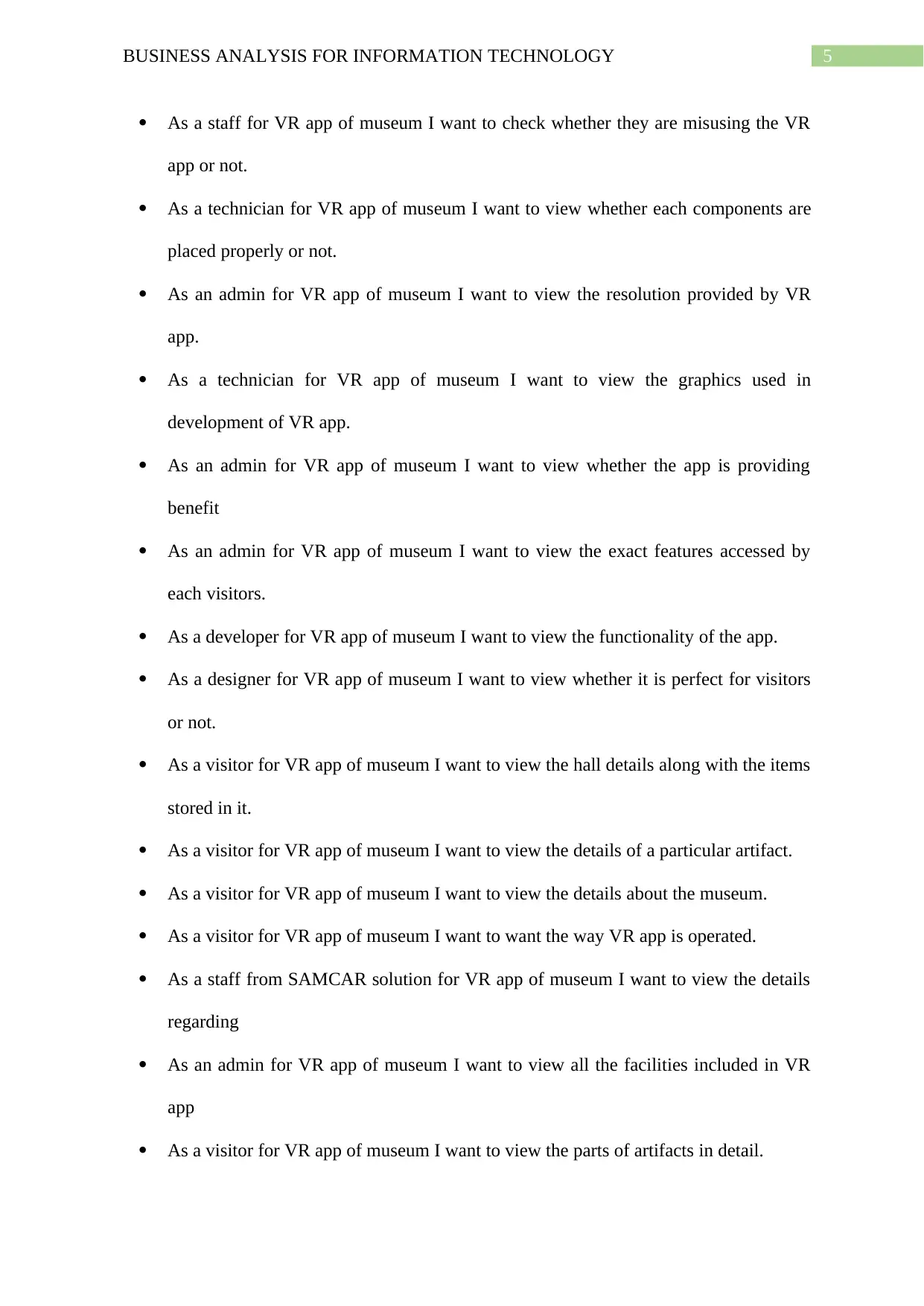
5BUSINESS ANALYSIS FOR INFORMATION TECHNOLOGY
As a staff for VR app of museum I want to check whether they are misusing the VR
app or not.
As a technician for VR app of museum I want to view whether each components are
placed properly or not.
As an admin for VR app of museum I want to view the resolution provided by VR
app.
As a technician for VR app of museum I want to view the graphics used in
development of VR app.
As an admin for VR app of museum I want to view whether the app is providing
benefit
As an admin for VR app of museum I want to view the exact features accessed by
each visitors.
As a developer for VR app of museum I want to view the functionality of the app.
As a designer for VR app of museum I want to view whether it is perfect for visitors
or not.
As a visitor for VR app of museum I want to view the hall details along with the items
stored in it.
As a visitor for VR app of museum I want to view the details of a particular artifact.
As a visitor for VR app of museum I want to view the details about the museum.
As a visitor for VR app of museum I want to want the way VR app is operated.
As a staff from SAMCAR solution for VR app of museum I want to view the details
regarding
As an admin for VR app of museum I want to view all the facilities included in VR
app
As a visitor for VR app of museum I want to view the parts of artifacts in detail.
As a staff for VR app of museum I want to check whether they are misusing the VR
app or not.
As a technician for VR app of museum I want to view whether each components are
placed properly or not.
As an admin for VR app of museum I want to view the resolution provided by VR
app.
As a technician for VR app of museum I want to view the graphics used in
development of VR app.
As an admin for VR app of museum I want to view whether the app is providing
benefit
As an admin for VR app of museum I want to view the exact features accessed by
each visitors.
As a developer for VR app of museum I want to view the functionality of the app.
As a designer for VR app of museum I want to view whether it is perfect for visitors
or not.
As a visitor for VR app of museum I want to view the hall details along with the items
stored in it.
As a visitor for VR app of museum I want to view the details of a particular artifact.
As a visitor for VR app of museum I want to view the details about the museum.
As a visitor for VR app of museum I want to want the way VR app is operated.
As a staff from SAMCAR solution for VR app of museum I want to view the details
regarding
As an admin for VR app of museum I want to view all the facilities included in VR
app
As a visitor for VR app of museum I want to view the parts of artifacts in detail.
⊘ This is a preview!⊘
Do you want full access?
Subscribe today to unlock all pages.

Trusted by 1+ million students worldwide
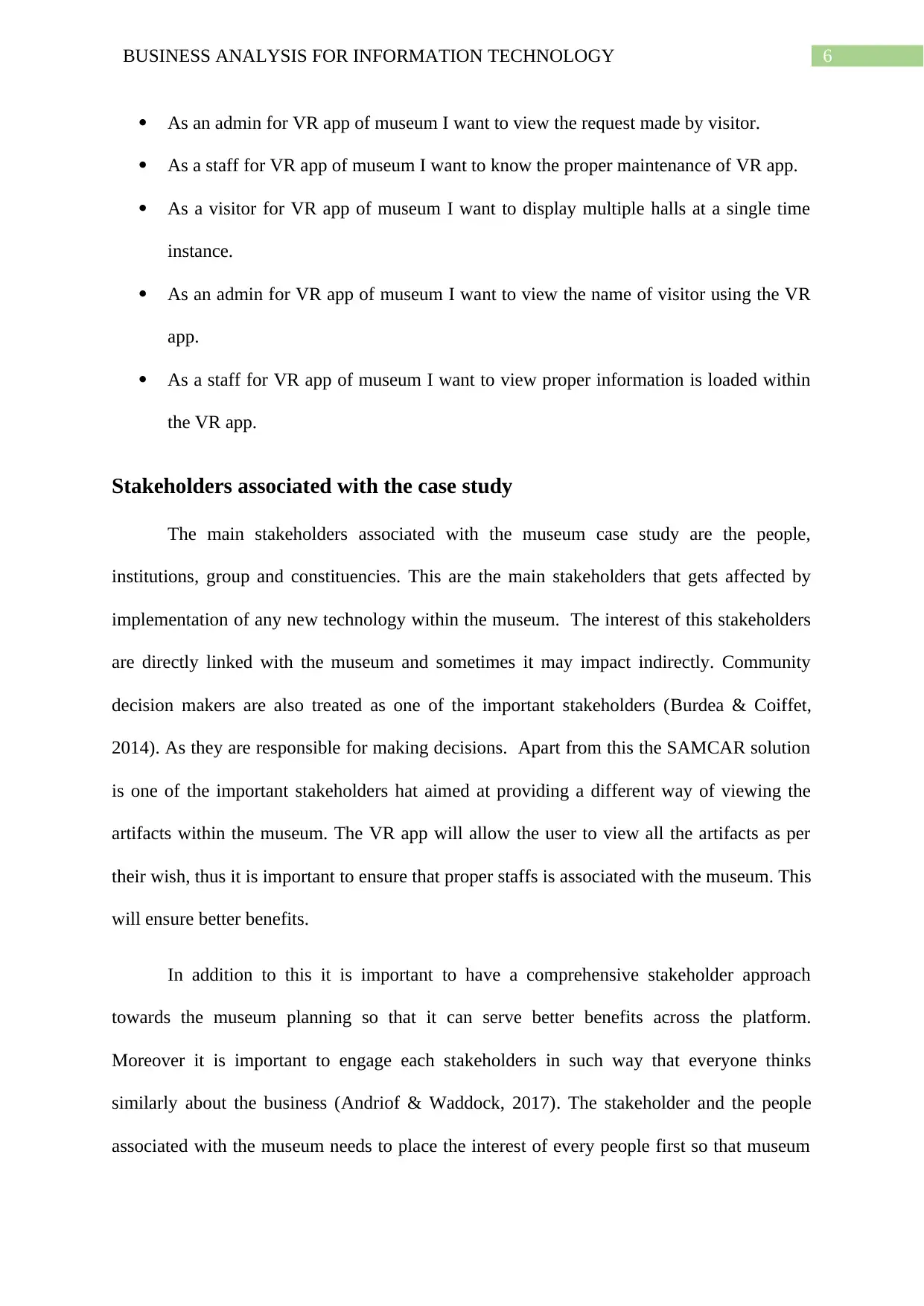
6BUSINESS ANALYSIS FOR INFORMATION TECHNOLOGY
As an admin for VR app of museum I want to view the request made by visitor.
As a staff for VR app of museum I want to know the proper maintenance of VR app.
As a visitor for VR app of museum I want to display multiple halls at a single time
instance.
As an admin for VR app of museum I want to view the name of visitor using the VR
app.
As a staff for VR app of museum I want to view proper information is loaded within
the VR app.
Stakeholders associated with the case study
The main stakeholders associated with the museum case study are the people,
institutions, group and constituencies. This are the main stakeholders that gets affected by
implementation of any new technology within the museum. The interest of this stakeholders
are directly linked with the museum and sometimes it may impact indirectly. Community
decision makers are also treated as one of the important stakeholders (Burdea & Coiffet,
2014). As they are responsible for making decisions. Apart from this the SAMCAR solution
is one of the important stakeholders hat aimed at providing a different way of viewing the
artifacts within the museum. The VR app will allow the user to view all the artifacts as per
their wish, thus it is important to ensure that proper staffs is associated with the museum. This
will ensure better benefits.
In addition to this it is important to have a comprehensive stakeholder approach
towards the museum planning so that it can serve better benefits across the platform.
Moreover it is important to engage each stakeholders in such way that everyone thinks
similarly about the business (Andriof & Waddock, 2017). The stakeholder and the people
associated with the museum needs to place the interest of every people first so that museum
As an admin for VR app of museum I want to view the request made by visitor.
As a staff for VR app of museum I want to know the proper maintenance of VR app.
As a visitor for VR app of museum I want to display multiple halls at a single time
instance.
As an admin for VR app of museum I want to view the name of visitor using the VR
app.
As a staff for VR app of museum I want to view proper information is loaded within
the VR app.
Stakeholders associated with the case study
The main stakeholders associated with the museum case study are the people,
institutions, group and constituencies. This are the main stakeholders that gets affected by
implementation of any new technology within the museum. The interest of this stakeholders
are directly linked with the museum and sometimes it may impact indirectly. Community
decision makers are also treated as one of the important stakeholders (Burdea & Coiffet,
2014). As they are responsible for making decisions. Apart from this the SAMCAR solution
is one of the important stakeholders hat aimed at providing a different way of viewing the
artifacts within the museum. The VR app will allow the user to view all the artifacts as per
their wish, thus it is important to ensure that proper staffs is associated with the museum. This
will ensure better benefits.
In addition to this it is important to have a comprehensive stakeholder approach
towards the museum planning so that it can serve better benefits across the platform.
Moreover it is important to engage each stakeholders in such way that everyone thinks
similarly about the business (Andriof & Waddock, 2017). The stakeholder and the people
associated with the museum needs to place the interest of every people first so that museum
Paraphrase This Document
Need a fresh take? Get an instant paraphrase of this document with our AI Paraphraser
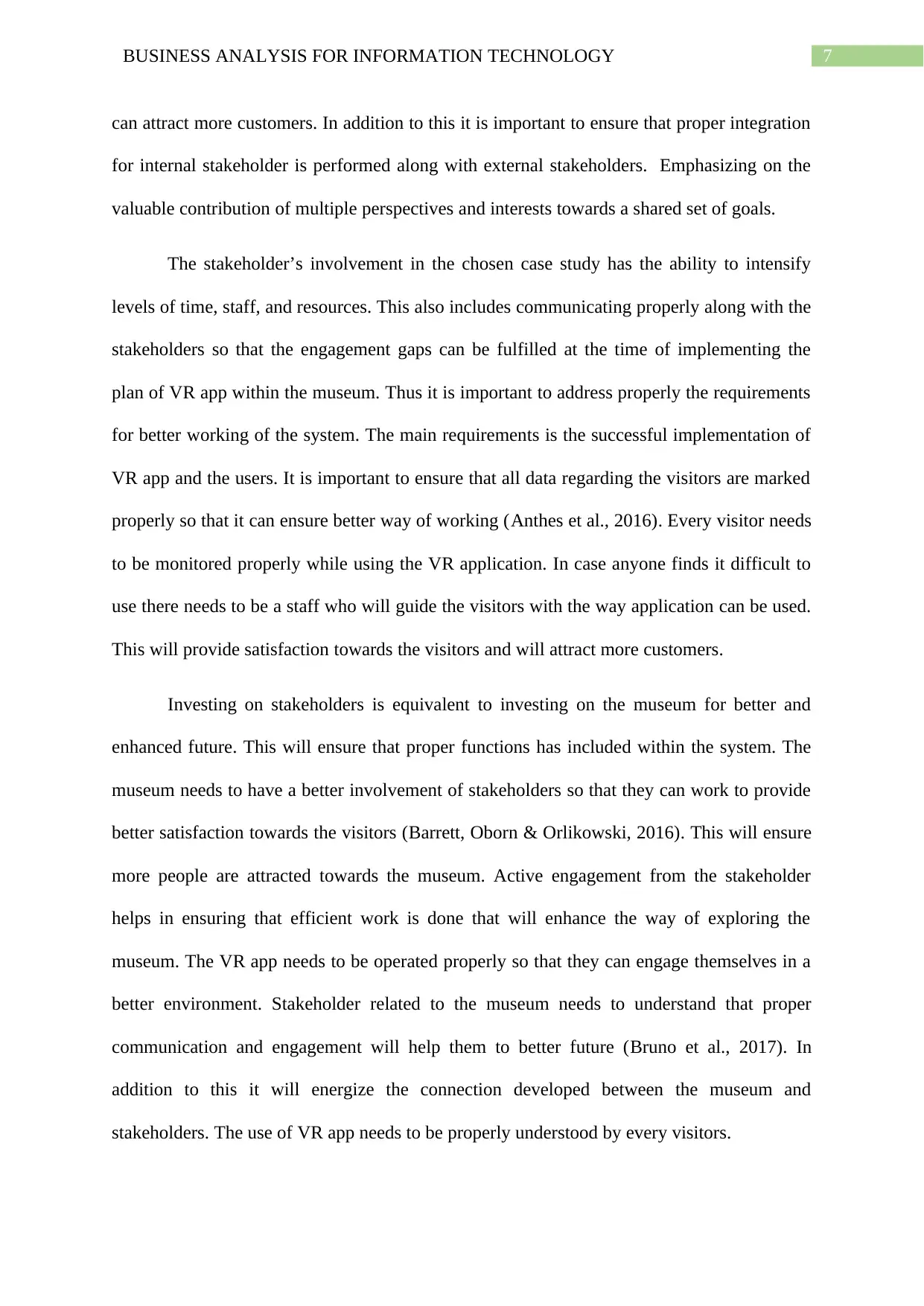
7BUSINESS ANALYSIS FOR INFORMATION TECHNOLOGY
can attract more customers. In addition to this it is important to ensure that proper integration
for internal stakeholder is performed along with external stakeholders. Emphasizing on the
valuable contribution of multiple perspectives and interests towards a shared set of goals.
The stakeholder’s involvement in the chosen case study has the ability to intensify
levels of time, staff, and resources. This also includes communicating properly along with the
stakeholders so that the engagement gaps can be fulfilled at the time of implementing the
plan of VR app within the museum. Thus it is important to address properly the requirements
for better working of the system. The main requirements is the successful implementation of
VR app and the users. It is important to ensure that all data regarding the visitors are marked
properly so that it can ensure better way of working (Anthes et al., 2016). Every visitor needs
to be monitored properly while using the VR application. In case anyone finds it difficult to
use there needs to be a staff who will guide the visitors with the way application can be used.
This will provide satisfaction towards the visitors and will attract more customers.
Investing on stakeholders is equivalent to investing on the museum for better and
enhanced future. This will ensure that proper functions has included within the system. The
museum needs to have a better involvement of stakeholders so that they can work to provide
better satisfaction towards the visitors (Barrett, Oborn & Orlikowski, 2016). This will ensure
more people are attracted towards the museum. Active engagement from the stakeholder
helps in ensuring that efficient work is done that will enhance the way of exploring the
museum. The VR app needs to be operated properly so that they can engage themselves in a
better environment. Stakeholder related to the museum needs to understand that proper
communication and engagement will help them to better future (Bruno et al., 2017). In
addition to this it will energize the connection developed between the museum and
stakeholders. The use of VR app needs to be properly understood by every visitors.
can attract more customers. In addition to this it is important to ensure that proper integration
for internal stakeholder is performed along with external stakeholders. Emphasizing on the
valuable contribution of multiple perspectives and interests towards a shared set of goals.
The stakeholder’s involvement in the chosen case study has the ability to intensify
levels of time, staff, and resources. This also includes communicating properly along with the
stakeholders so that the engagement gaps can be fulfilled at the time of implementing the
plan of VR app within the museum. Thus it is important to address properly the requirements
for better working of the system. The main requirements is the successful implementation of
VR app and the users. It is important to ensure that all data regarding the visitors are marked
properly so that it can ensure better way of working (Anthes et al., 2016). Every visitor needs
to be monitored properly while using the VR application. In case anyone finds it difficult to
use there needs to be a staff who will guide the visitors with the way application can be used.
This will provide satisfaction towards the visitors and will attract more customers.
Investing on stakeholders is equivalent to investing on the museum for better and
enhanced future. This will ensure that proper functions has included within the system. The
museum needs to have a better involvement of stakeholders so that they can work to provide
better satisfaction towards the visitors (Barrett, Oborn & Orlikowski, 2016). This will ensure
more people are attracted towards the museum. Active engagement from the stakeholder
helps in ensuring that efficient work is done that will enhance the way of exploring the
museum. The VR app needs to be operated properly so that they can engage themselves in a
better environment. Stakeholder related to the museum needs to understand that proper
communication and engagement will help them to better future (Bruno et al., 2017). In
addition to this it will energize the connection developed between the museum and
stakeholders. The use of VR app needs to be properly understood by every visitors.
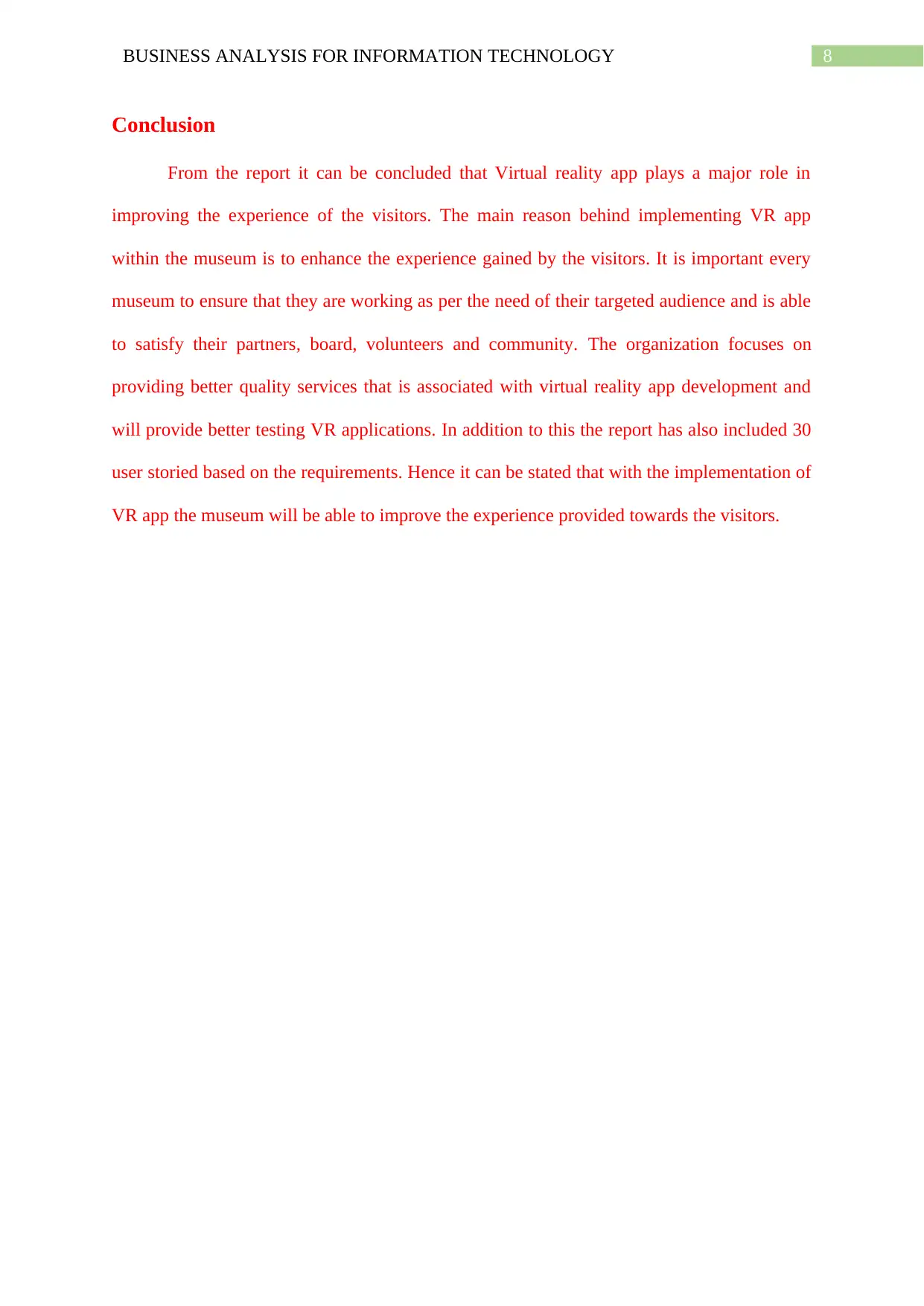
8BUSINESS ANALYSIS FOR INFORMATION TECHNOLOGY
Conclusion
From the report it can be concluded that Virtual reality app plays a major role in
improving the experience of the visitors. The main reason behind implementing VR app
within the museum is to enhance the experience gained by the visitors. It is important every
museum to ensure that they are working as per the need of their targeted audience and is able
to satisfy their partners, board, volunteers and community. The organization focuses on
providing better quality services that is associated with virtual reality app development and
will provide better testing VR applications. In addition to this the report has also included 30
user storied based on the requirements. Hence it can be stated that with the implementation of
VR app the museum will be able to improve the experience provided towards the visitors.
Conclusion
From the report it can be concluded that Virtual reality app plays a major role in
improving the experience of the visitors. The main reason behind implementing VR app
within the museum is to enhance the experience gained by the visitors. It is important every
museum to ensure that they are working as per the need of their targeted audience and is able
to satisfy their partners, board, volunteers and community. The organization focuses on
providing better quality services that is associated with virtual reality app development and
will provide better testing VR applications. In addition to this the report has also included 30
user storied based on the requirements. Hence it can be stated that with the implementation of
VR app the museum will be able to improve the experience provided towards the visitors.
⊘ This is a preview!⊘
Do you want full access?
Subscribe today to unlock all pages.

Trusted by 1+ million students worldwide
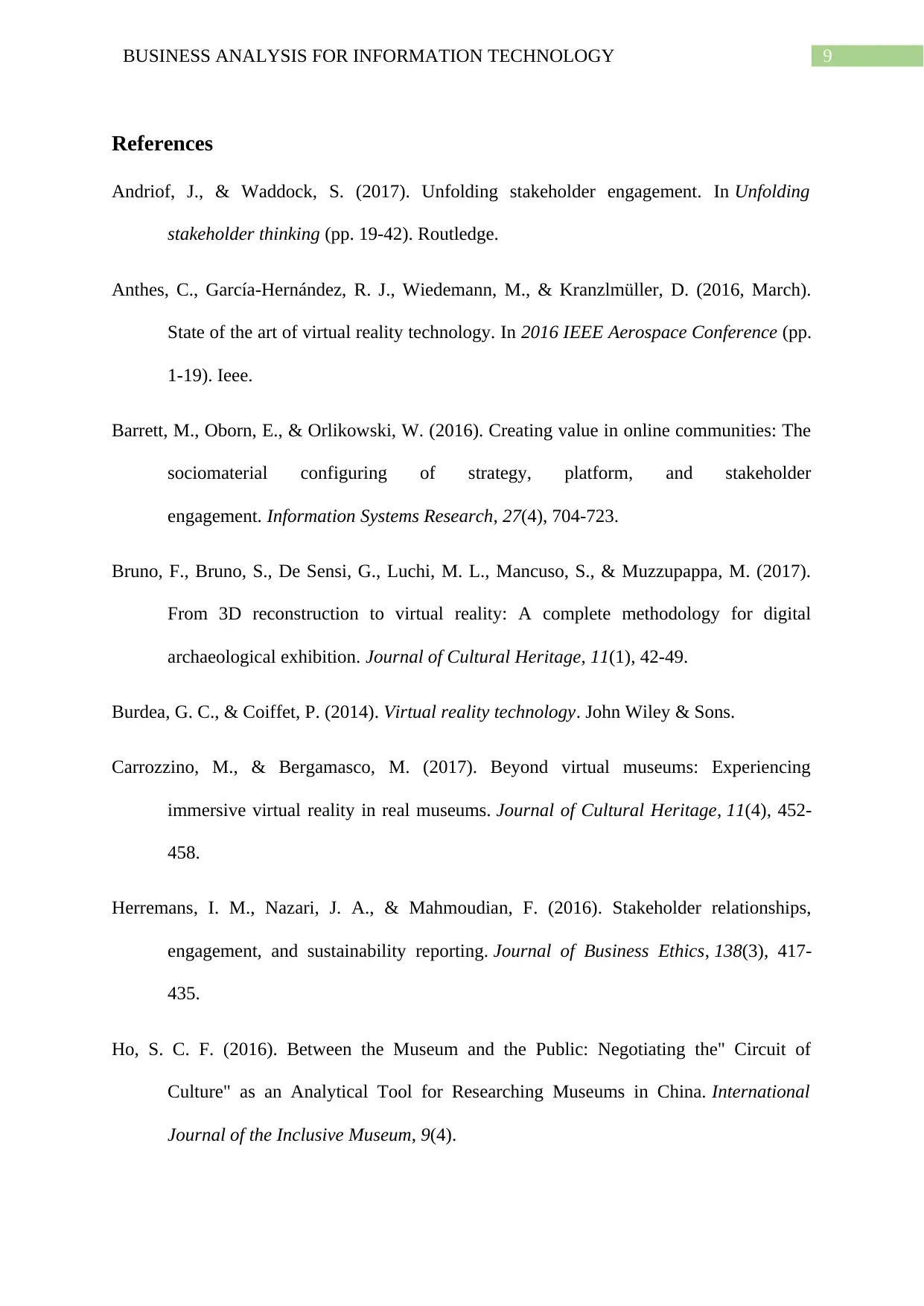
9BUSINESS ANALYSIS FOR INFORMATION TECHNOLOGY
References
Andriof, J., & Waddock, S. (2017). Unfolding stakeholder engagement. In Unfolding
stakeholder thinking (pp. 19-42). Routledge.
Anthes, C., García-Hernández, R. J., Wiedemann, M., & Kranzlmüller, D. (2016, March).
State of the art of virtual reality technology. In 2016 IEEE Aerospace Conference (pp.
1-19). Ieee.
Barrett, M., Oborn, E., & Orlikowski, W. (2016). Creating value in online communities: The
sociomaterial configuring of strategy, platform, and stakeholder
engagement. Information Systems Research, 27(4), 704-723.
Bruno, F., Bruno, S., De Sensi, G., Luchi, M. L., Mancuso, S., & Muzzupappa, M. (2017).
From 3D reconstruction to virtual reality: A complete methodology for digital
archaeological exhibition. Journal of Cultural Heritage, 11(1), 42-49.
Burdea, G. C., & Coiffet, P. (2014). Virtual reality technology. John Wiley & Sons.
Carrozzino, M., & Bergamasco, M. (2017). Beyond virtual museums: Experiencing
immersive virtual reality in real museums. Journal of Cultural Heritage, 11(4), 452-
458.
Herremans, I. M., Nazari, J. A., & Mahmoudian, F. (2016). Stakeholder relationships,
engagement, and sustainability reporting. Journal of Business Ethics, 138(3), 417-
435.
Ho, S. C. F. (2016). Between the Museum and the Public: Negotiating the" Circuit of
Culture" as an Analytical Tool for Researching Museums in China. International
Journal of the Inclusive Museum, 9(4).
References
Andriof, J., & Waddock, S. (2017). Unfolding stakeholder engagement. In Unfolding
stakeholder thinking (pp. 19-42). Routledge.
Anthes, C., García-Hernández, R. J., Wiedemann, M., & Kranzlmüller, D. (2016, March).
State of the art of virtual reality technology. In 2016 IEEE Aerospace Conference (pp.
1-19). Ieee.
Barrett, M., Oborn, E., & Orlikowski, W. (2016). Creating value in online communities: The
sociomaterial configuring of strategy, platform, and stakeholder
engagement. Information Systems Research, 27(4), 704-723.
Bruno, F., Bruno, S., De Sensi, G., Luchi, M. L., Mancuso, S., & Muzzupappa, M. (2017).
From 3D reconstruction to virtual reality: A complete methodology for digital
archaeological exhibition. Journal of Cultural Heritage, 11(1), 42-49.
Burdea, G. C., & Coiffet, P. (2014). Virtual reality technology. John Wiley & Sons.
Carrozzino, M., & Bergamasco, M. (2017). Beyond virtual museums: Experiencing
immersive virtual reality in real museums. Journal of Cultural Heritage, 11(4), 452-
458.
Herremans, I. M., Nazari, J. A., & Mahmoudian, F. (2016). Stakeholder relationships,
engagement, and sustainability reporting. Journal of Business Ethics, 138(3), 417-
435.
Ho, S. C. F. (2016). Between the Museum and the Public: Negotiating the" Circuit of
Culture" as an Analytical Tool for Researching Museums in China. International
Journal of the Inclusive Museum, 9(4).
Paraphrase This Document
Need a fresh take? Get an instant paraphrase of this document with our AI Paraphraser
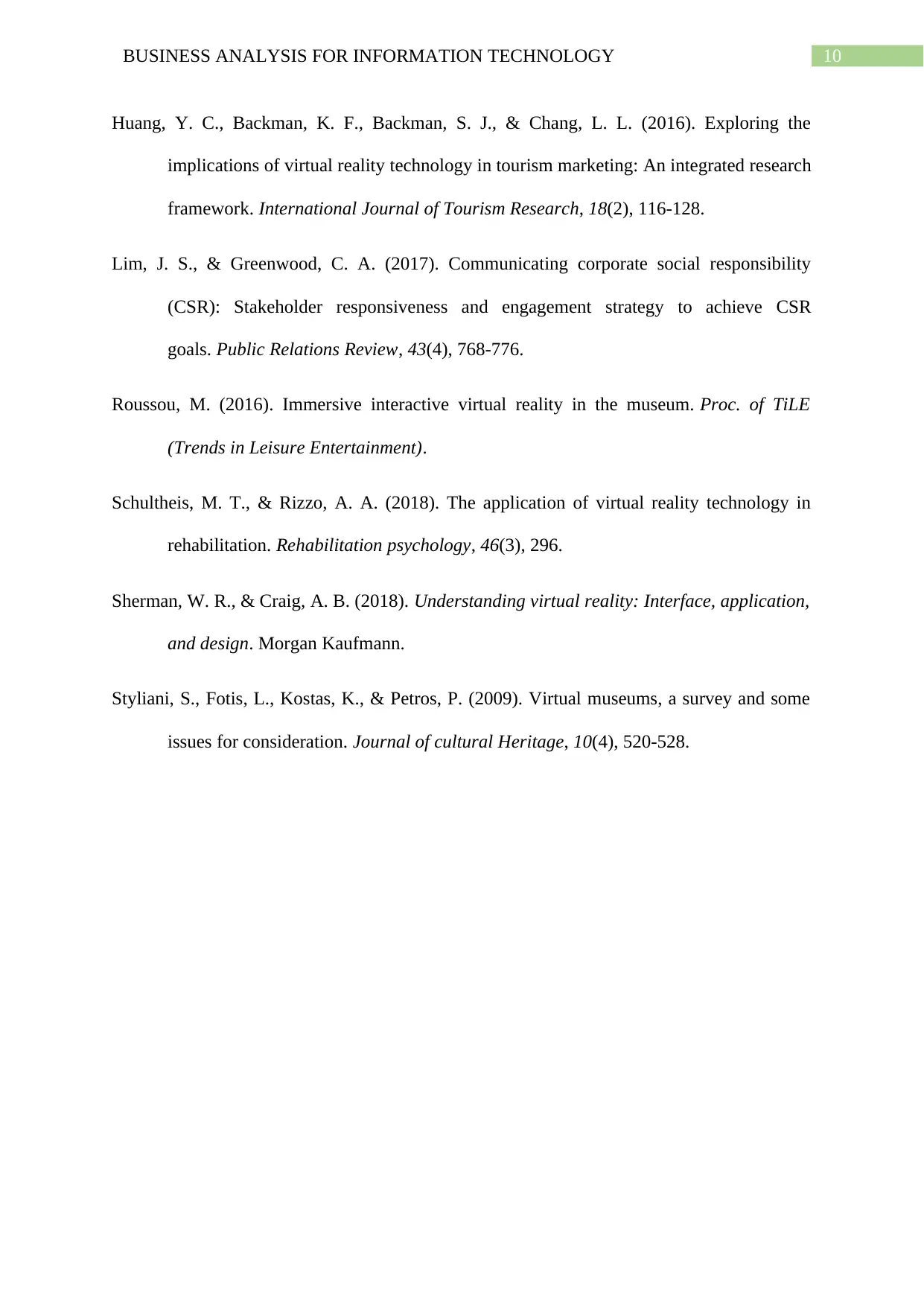
10BUSINESS ANALYSIS FOR INFORMATION TECHNOLOGY
Huang, Y. C., Backman, K. F., Backman, S. J., & Chang, L. L. (2016). Exploring the
implications of virtual reality technology in tourism marketing: An integrated research
framework. International Journal of Tourism Research, 18(2), 116-128.
Lim, J. S., & Greenwood, C. A. (2017). Communicating corporate social responsibility
(CSR): Stakeholder responsiveness and engagement strategy to achieve CSR
goals. Public Relations Review, 43(4), 768-776.
Roussou, M. (2016). Immersive interactive virtual reality in the museum. Proc. of TiLE
(Trends in Leisure Entertainment).
Schultheis, M. T., & Rizzo, A. A. (2018). The application of virtual reality technology in
rehabilitation. Rehabilitation psychology, 46(3), 296.
Sherman, W. R., & Craig, A. B. (2018). Understanding virtual reality: Interface, application,
and design. Morgan Kaufmann.
Styliani, S., Fotis, L., Kostas, K., & Petros, P. (2009). Virtual museums, a survey and some
issues for consideration. Journal of cultural Heritage, 10(4), 520-528.
Huang, Y. C., Backman, K. F., Backman, S. J., & Chang, L. L. (2016). Exploring the
implications of virtual reality technology in tourism marketing: An integrated research
framework. International Journal of Tourism Research, 18(2), 116-128.
Lim, J. S., & Greenwood, C. A. (2017). Communicating corporate social responsibility
(CSR): Stakeholder responsiveness and engagement strategy to achieve CSR
goals. Public Relations Review, 43(4), 768-776.
Roussou, M. (2016). Immersive interactive virtual reality in the museum. Proc. of TiLE
(Trends in Leisure Entertainment).
Schultheis, M. T., & Rizzo, A. A. (2018). The application of virtual reality technology in
rehabilitation. Rehabilitation psychology, 46(3), 296.
Sherman, W. R., & Craig, A. B. (2018). Understanding virtual reality: Interface, application,
and design. Morgan Kaufmann.
Styliani, S., Fotis, L., Kostas, K., & Petros, P. (2009). Virtual museums, a survey and some
issues for consideration. Journal of cultural Heritage, 10(4), 520-528.
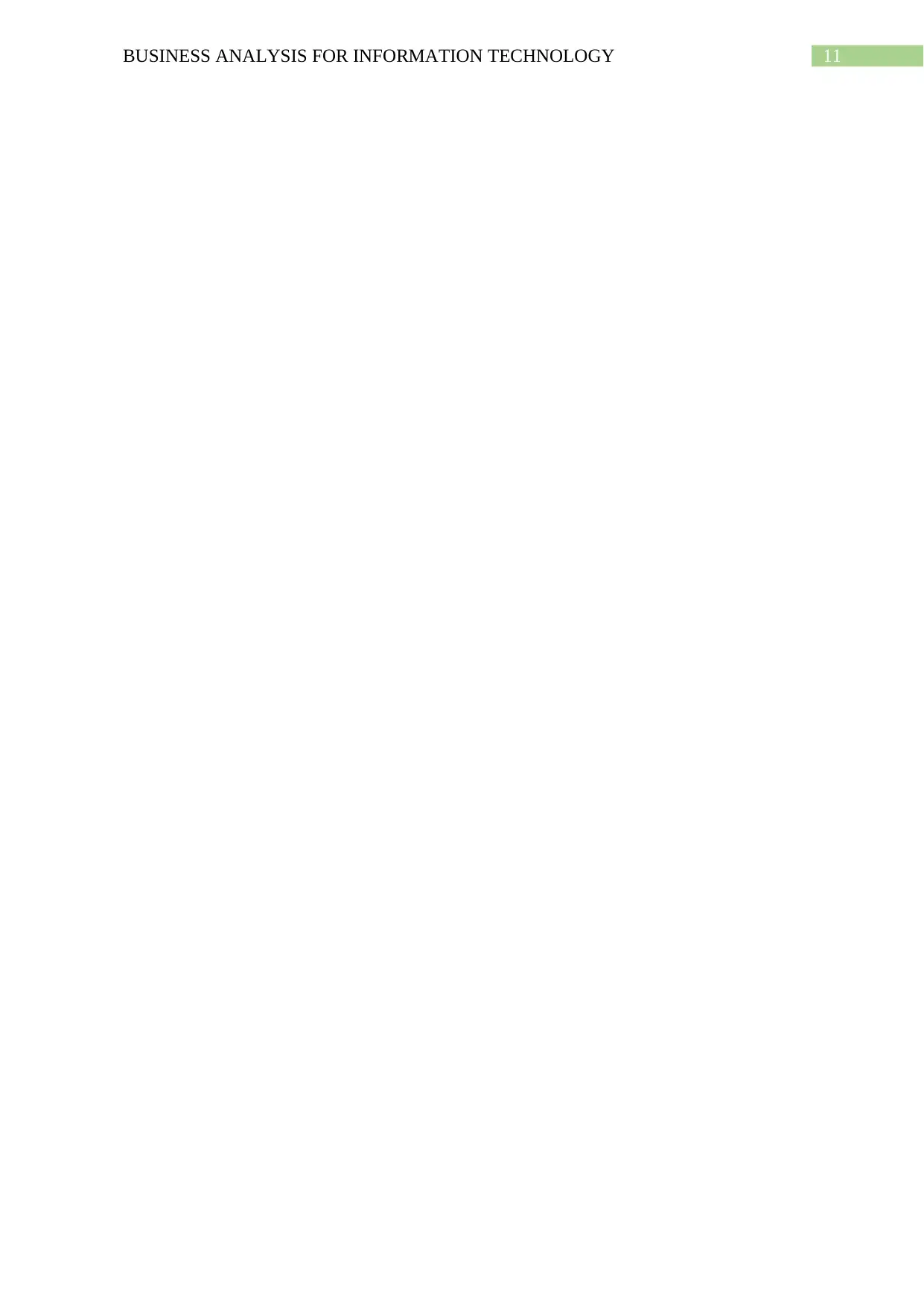
11BUSINESS ANALYSIS FOR INFORMATION TECHNOLOGY
⊘ This is a preview!⊘
Do you want full access?
Subscribe today to unlock all pages.

Trusted by 1+ million students worldwide
1 out of 12
Related Documents
Your All-in-One AI-Powered Toolkit for Academic Success.
+13062052269
info@desklib.com
Available 24*7 on WhatsApp / Email
![[object Object]](/_next/static/media/star-bottom.7253800d.svg)
Unlock your academic potential
Copyright © 2020–2025 A2Z Services. All Rights Reserved. Developed and managed by ZUCOL.





